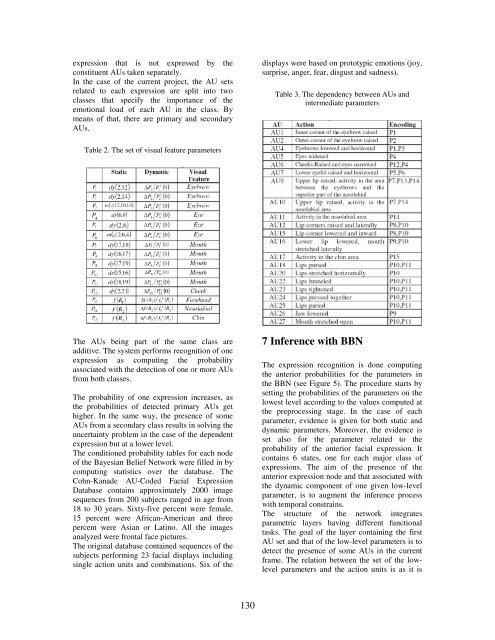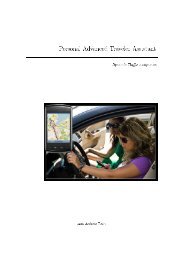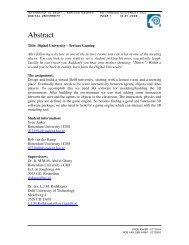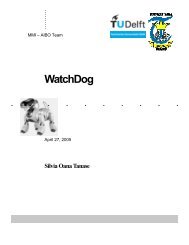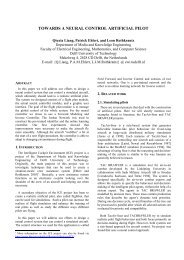Recognition of facial expressions - Knowledge Based Systems ...
Recognition of facial expressions - Knowledge Based Systems ...
Recognition of facial expressions - Knowledge Based Systems ...
Create successful ePaper yourself
Turn your PDF publications into a flip-book with our unique Google optimized e-Paper software.
expression that is not expressed by the<br />
constituent AUs taken separately.<br />
In the case <strong>of</strong> the current project, the AU sets<br />
related to each expression are split into two<br />
classes that specify the importance <strong>of</strong> the<br />
emotional load <strong>of</strong> each AU in the class. By<br />
means <strong>of</strong> that, there are primary and secondary<br />
AUs.<br />
displays were based on prototypic emotions (joy,<br />
surprise, anger, fear, disgust and sadness).<br />
Table 3. The dependency between AUs and<br />
intermediate parameters<br />
Table 2. The set <strong>of</strong> visual feature parameters<br />
The AUs being part <strong>of</strong> the same class are<br />
additive. The system performs recognition <strong>of</strong> one<br />
expression as computing the probability<br />
associated with the detection <strong>of</strong> one or more AUs<br />
from both classes.<br />
The probability <strong>of</strong> one expression increases, as<br />
the probabilities <strong>of</strong> detected primary AUs get<br />
higher. In the same way, the presence <strong>of</strong> some<br />
AUs from a secondary class results in solving the<br />
uncertainty problem in the case <strong>of</strong> the dependent<br />
expression but at a lower level.<br />
The conditioned probability tables for each node<br />
<strong>of</strong> the Bayesian Belief Network were filled in by<br />
computing statistics over the database. The<br />
Cohn-Kanade AU-Coded Facial Expression<br />
Database contains approximately 2000 image<br />
sequences from 200 subjects ranged in age from<br />
18 to 30 years. Sixty-five percent were female,<br />
15 percent were African-American and three<br />
percent were Asian or Latino. All the images<br />
analyzed were frontal face pictures.<br />
The original database contained sequences <strong>of</strong> the<br />
subjects performing 23 <strong>facial</strong> displays including<br />
single action units and combinations. Six <strong>of</strong> the<br />
7 Inference with BBN<br />
The expression recognition is done computing<br />
the anterior probabilities for the parameters in<br />
the BBN (see Figure 5). The procedure starts by<br />
setting the probabilities <strong>of</strong> the parameters on the<br />
lowest level according to the values computed at<br />
the preprocessing stage. In the case <strong>of</strong> each<br />
parameter, evidence is given for both static and<br />
dynamic parameters. Moreover, the evidence is<br />
set also for the parameter related to the<br />
probability <strong>of</strong> the anterior <strong>facial</strong> expression. It<br />
contains 6 states, one for each major class <strong>of</strong><br />
<strong>expressions</strong>. The aim <strong>of</strong> the presence <strong>of</strong> the<br />
anterior expression node and that associated with<br />
the dynamic component <strong>of</strong> one given low-level<br />
parameter, is to augment the inference process<br />
with temporal constrains.<br />
The structure <strong>of</strong> the network integrates<br />
parametric layers having different functional<br />
tasks. The goal <strong>of</strong> the layer containing the first<br />
AU set and that <strong>of</strong> the low-level parameters is to<br />
detect the presence <strong>of</strong> some AUs in the current<br />
frame. The relation between the set <strong>of</strong> the lowlevel<br />
parameters and the action units is as it is<br />
130


